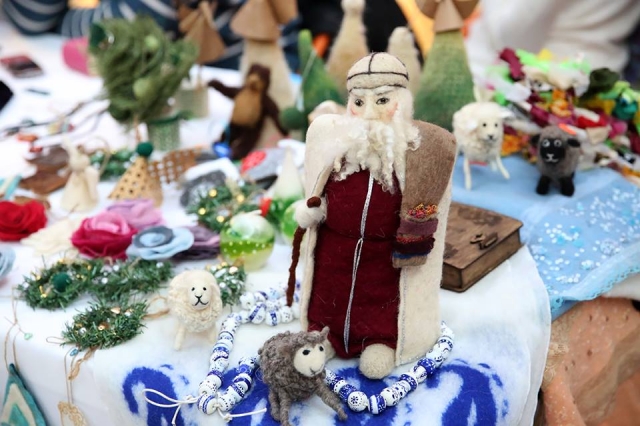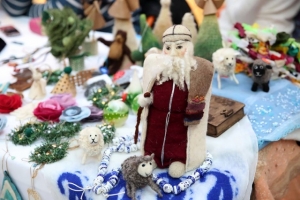Doing Christmas, New Year Georgian Style
The long-awaited winter holidays in Georgia, New Year and Christmas, are just around the corner.
Georgians love to celebrate their holidays in a noisy way with big traditional supras (feasts), which includes an unlimited amount of dishes, snacks and drinks. People in Georgia have a special talent to turn any holiday celebration into a feast, involving all family members and friends.
This unusual style of holiday celebration attracts tourists from around the world to pack up and head to Georgia to share the very unique holiday spirit.
The celebration of the winter holidays in Georgia lasts for around two weeks and has a unique Georgian spirit. While the western world celebrates Christmas before the New Year, on December 25, in Georgia it is done in reverse; first the Georgians celebrate New Year, on January 1st as the West, then Bedoba (the day of luck) on January 2, and following that comes Christmas, in the style of the Orthodox world which celebrates the birth of the lord on January 7. Then comes Old New Year on January 14.
We advise you to allow adequate time for your winter break, though, since your hosts will probably not let you leave the table until you have tried all the dishes and drunk all the wine offered. In short, the feasting alone takes up a lot of time! And the feasting is but a small part of what makes a Georgian Christmas.
Alongside the well-known Christmas (Fir) Tree, Georgians also have their own traditional decoration, made from nut wood twigs with long white fluffy shavings, called a Chichilaki.
The curly shavings, which the master removes moving upwards from the bottom, are called basila, in honor of St. Vasily’s beard, the patron saint of animals and harbinger of new happiness.
Chichilaki are usually decorated with an assortment of fruits, berries and flowers as offerings to heaven for a bountiful harvest. Georgians believe that this white Christmas Tree will bring luck and a good year for their families. Once the Christmas holidays are over, people burn their trees on the day before the Georgian Orthodox Epiphany, on January 19, believing that the previous year’s misfortunes go up in smoke with the tree.
The chain of celebrations usually kicks off on New Year’s Eve, with the festive table laden to breaking point with the most delicious homemade food, beautifully and richly presented, an abundance of various fruits, freshly picked vegetables, nuts and homemade sweets.
Satsivi, a thick paste made from walnuts and served cold (‘Tsivi’ means ‘cold’ in Georgian) with chicken or turkey in it, and Gozinaki, a traditional Georgian confection made of caramelized nuts fried in honey, are two must-haves of the New Year.
Homemade wine, warm cheers for the upcoming year and the famous polyphonic singing will make this holiday joyful and unforgettable.
Following New Year, on January 2, Georgian’s celebrate Bedoba, a day of luck. The Mekvle is the main person of the day. He or she is the first guest ‘with happy feet’ to arrive at the house in the New Year, symbolically bringing in joy and prosperity.
The Mekvle is welcomed with a basket of delicacies in exchange for the candies s/he brings to the family to make the upcoming year sweet. The guest is usually either selected in advance from a circle of close friends or the role is taken on by a family member who leaves the room and reappears again, bringing happiness and joy.
Christmas is the most honoured and loved holiday for Georgians. Traditionally, on the eve of Christmas, which is marked on January 7, most believers head to church at midnight to meet Christmas. After returning from church, Georgians light candles inside their homes and sit down to celebrate with more delicacies, as for many Georgians the birth of Christ symbolizes the end of the fasting period which lasts for 40 days.
At the close of Christmas day, Georgians bake a special Christmas pie, with eggs and cheese inside.
In the morning, all citizens of Tbilisi wait for the festive Alilo procession in which clergymen pass along the streets of the city carrying icons, crosses and flags and praising the birth of Christ in song.
Children dressed in white usually lead the procession, symbolizing angels on foot. As the ceremony proceeds, the participants collect donations and gifts to be given to orphanages and people in need.
And the final accord of the long lasting holiday celebration is Old New Year, which, as paradoxical as it may sound, finally concludes the winter celebrations.
This holiday, celebrated on January 14, marks the New Year according to the old Julian calendar, as opposed to the Gregorian one which the world officially celebrates in modern days.
It is a tradition observed by the majority of Georgians, many of whom do not even take the Christmas tree down before this date. The Old New Year is celebrated in a similar way to the regular New Year: with a festive table, an abundance of wine, and bringing together joyful and friendly people to start the year as they mean it to go on.
Photo: Tbilisi City Hall.
Tamar Svanidze











